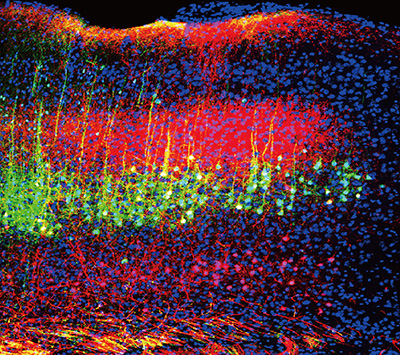How Sound Reduces Pain in Mice
Newly identified brain circuits may point to more effective pain therapies
An international team of scientists has identified the neural mechanisms through which sound blunts pain in mice. The findings, which could inform development of safer methods to treat pain, were published in Science. The study was led by researchers at NIDCR; the University of Science and Technology of China, Hefei; and Anhui Medical University, Hefei, China.
“We need more effective methods of managing acute and chronic pain, and that starts with gaining a better understanding of the basic neural processes that regulate pain,” said NIDCR Director Rena D’Souza, DDS, PhD. “By uncovering the circuitry that mediates the pain-reducing effects of sound in mice, this study adds critical knowledge that could ultimately inform new approaches for pain therapy.”
Dating back to 1960, studies in humans have shown that music and other kinds of sound can help alleviate acute and chronic pain, including pain from dental and medical surgery, labor and delivery, and cancer. However, how the brain produces this pain reduction, or analgesia, was less clear.
“Human brain imaging studies have implicated certain areas of the brain in music-induced analgesia, but these are only associations,” said co-senior author Yuanyuan (Kevin) Liu, PhD, a Stadtman tenure-track investigator at NIDCR. “In animals, we can more fully explore and manipulate the circuitry to identify the neural substrates involved.”
The researchers first exposed mice with inflamed paws to three types of sound: a pleasant piece of classical music, an unpleasant rearrangement of the same piece, and white noise. Surprisingly, all three types of sound, when played at a low intensity relative to background noise (about the level of a whisper) reduced pain sensitivity in the mice. Higher intensities of the same sounds had no effect on animals’ pain responses.
“We were really surprised that the intensity of sound, and not the category or perceived pleasantness of sound would matter,” Liu said.
To explore the brain circuitry underlying this effect, the researchers used non-infectious viruses coupled with fluorescent proteins to trace connections between brain regions. They identified a route from the auditory cortex, which receives and processes information about sound, to the thalamus, which acts as a relay station for sensory signals, including pain, from the body. In freely moving mice, low-intensity white noise reduced the activity of neurons at the receiving end of the pathway in the thalamus.
In the absence of sound, suppressing the pathway with light- and small molecule-based techniques mimicked the pain-blunting effects of low-intensity noise, while turning on the pathway restored animals’ sensitivity to pain.
Liu said it is unclear if similar brain processes are involved in humans, or whether other aspects of sound, such as its perceived harmony or pleasantness, are important for human pain relief.
“We don’t know if human music means anything to rodents, but it has many different meanings to humans—you have a lot of emotional components,” he said.
The results could give scientists a starting point for studies to determine whether the animal findings apply to humans, and ultimately could inform development of safer alternatives to opioids for treating pain.
Related Links
- Inflammation May Curb, Not Cause, Chronic Pain
- Facial Pain Comes to Light
- Dialing Down Pain from the Brain
Reference
Sound induces analgesia through corticothalamic circuits. Zhou W, Ye C, Wang H, Mao Y, Zhang W, Liu A, Yang CL, Li T, Hayashi L, Zhao W, Chen L, Liu Y, Tao W, Zhang Z. Science. 2022 Jul 8;377(6602):198-204. doi: 10.1126/science.abn4663. Epub 2022 Jul 7. PMID: 35857536.
Attention Editors
Reprint this article in your own publication or post to your website. NIDCR News articles are not copyrighted. Please acknowledge NIH's National Institute of Dental and Craniofacial Research as the source.
Subscribe for NIDCR Updates
Receive email updates about the latest advances in dental, oral, and craniofacial research.
October 2024

